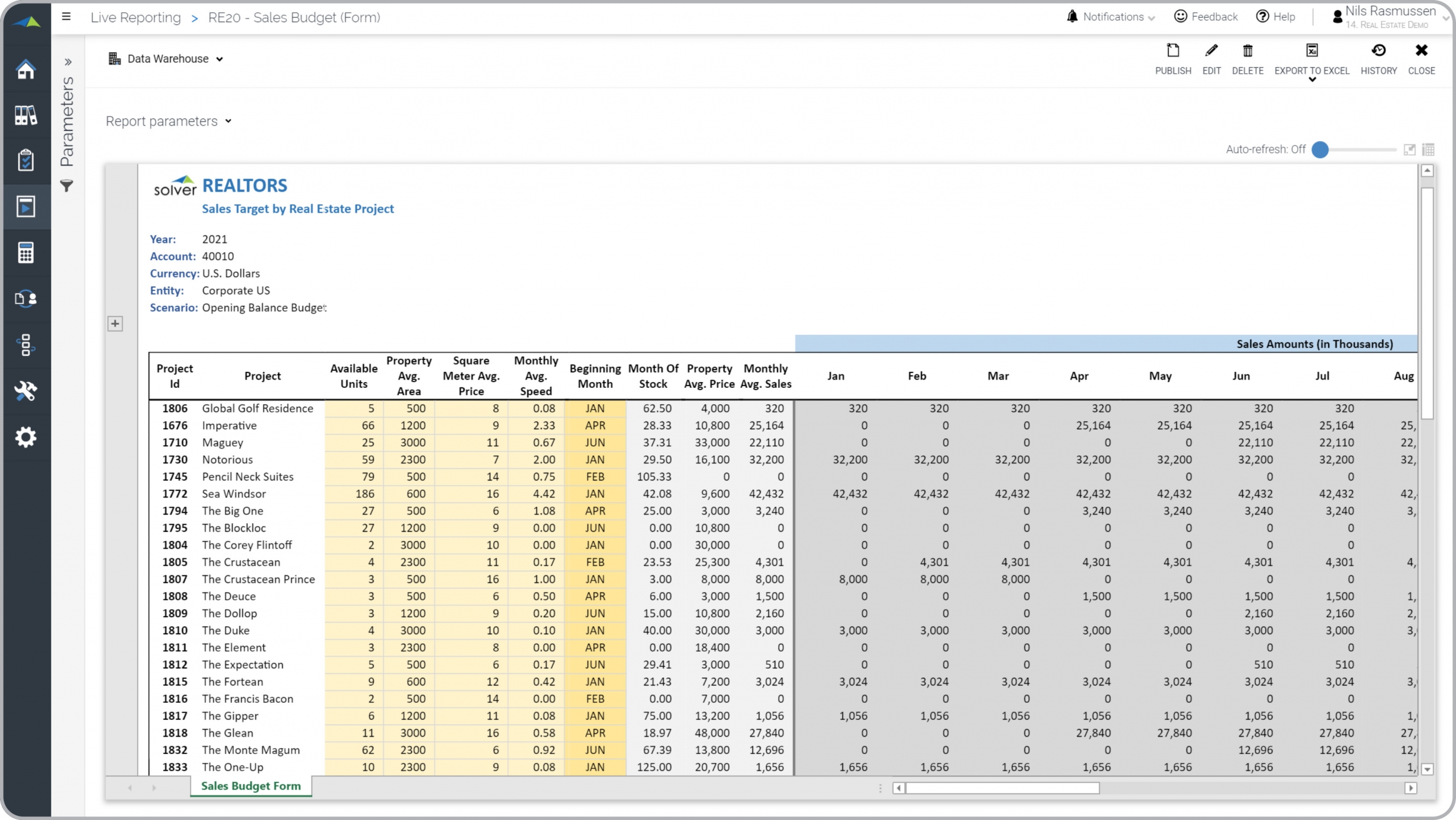Sales Forecast Model for Real Estate Companies
What is a Real Estate
Sales Forecast Model
? Sales Forecast Models are considered planning tools and are used by budgeting managers to collect sales drivers that generate forecasts. Some of the main functionality in this type of input form is that it uses drivers to automatically calculate the forecast (or budget) in the months seen across the columns. These driver inputs include: Available units, Property average area, Average price per square meter (or square foot), Monthly average speed (unit sales), and Beginning month (of sales). In the example below the form uses a configuration that lists real estate projects down the rows. You find an example of this type of input form below.
Purpose of
Real Estate Sales Forecast Models Real Estate companies use Sales Forecast Models to enable users to quickly and securely enter and update sales figures so the company has the best possible unit inventory and revenue estimate. When used as part of good business practices in Sales and Financial Planning and Analysis (FP&A) departments, a company can improve its strategies related to financing and real estate projects, and it can reduce the chances that managers makes uninformed decisions that ultimately can effect revenues and profitability.
Example of a
Real Estate Sales Forecast Model Here is an example of a Sales Forecast Input Form by project. [caption id="" align="alignnone" width="2560"]
 Example of a Sales Forecast Model for Real Estate Companies[/caption] You can find hundreds of additional examples
here
Who Uses This Type of
Input form
? The typical users of this type of input form are: CFOs, project planners, regional sales managers, budget managers and agents.
Other Reports Often Used in Conjunction with
Real Estate Sales Forecast Models Progressive Sales and Financial Planning and Analysis (FP&A) departments sometimes use several different Real Estate Sales Forecast Models, along with sales reports, sales dashboards, real estate inventory reports, financial statements, annual budget models, corporate forecasts and other management and control tools.
Where Does the Data for Analysis Originate From? The Actual (historical transactions) data typically comes from enterprise resource planning (ERP) systems like: Microsoft Dynamics 365 (D365) Finance, Microsoft Dynamics 365 Business Central (D365 BC), Microsoft Dynamics AX, Microsoft Dynamics NAV, Microsoft Dynamics GP, Microsoft Dynamics SL, Sage Intacct, Sage 100, Sage 300, Sage 500, Sage X3, SAP Business One, SAP ByDesign, Acumatica, Netsuite and others. In analyses where budgets or forecasts are used, the planning data most often originates from in-house Excel spreadsheet models or from professional corporate performance management (CPM/EPM) solutions.
What Tools are Typically used for Reporting, Planning and Dashboards? Examples of business software used with the data and ERPs mentioned above are:
Example of a Sales Forecast Model for Real Estate Companies[/caption] You can find hundreds of additional examples
here
Who Uses This Type of
Input form
? The typical users of this type of input form are: CFOs, project planners, regional sales managers, budget managers and agents.
Other Reports Often Used in Conjunction with
Real Estate Sales Forecast Models Progressive Sales and Financial Planning and Analysis (FP&A) departments sometimes use several different Real Estate Sales Forecast Models, along with sales reports, sales dashboards, real estate inventory reports, financial statements, annual budget models, corporate forecasts and other management and control tools.
Where Does the Data for Analysis Originate From? The Actual (historical transactions) data typically comes from enterprise resource planning (ERP) systems like: Microsoft Dynamics 365 (D365) Finance, Microsoft Dynamics 365 Business Central (D365 BC), Microsoft Dynamics AX, Microsoft Dynamics NAV, Microsoft Dynamics GP, Microsoft Dynamics SL, Sage Intacct, Sage 100, Sage 300, Sage 500, Sage X3, SAP Business One, SAP ByDesign, Acumatica, Netsuite and others. In analyses where budgets or forecasts are used, the planning data most often originates from in-house Excel spreadsheet models or from professional corporate performance management (CPM/EPM) solutions.
What Tools are Typically used for Reporting, Planning and Dashboards? Examples of business software used with the data and ERPs mentioned above are:
- Native ERP report writers and query tools
- Spreadsheets (for example Microsoft Excel)
- Corporate Performance Management (CPM) tools (for example Solver)
- Dashboards (for example Microsoft Power BI and Tableau)
Corporate Performance Management (CPM) Cloud Solutions and More Examples
June 27, 2021
TAGS:
Reporting,
Solver,
report writer,
Microsoft,
template,
practice,
Acumatica,
Netsuite,
Finance,
planning,
GP,
Business Central,
excel,
ax,
forecast,
Budget,
estimate,
Dynamics 365,
sales forecast,
price,
budgeting,
target,
Cloud,
Software,
Tableau,
SAP,
example,
best,
Sage,
BC,
D365,
NAV,
Intacct,
Real Estate,
project,
CPM,
report,
SL,
Management,
dynamics,
sales,
Power BI,
property,
area

